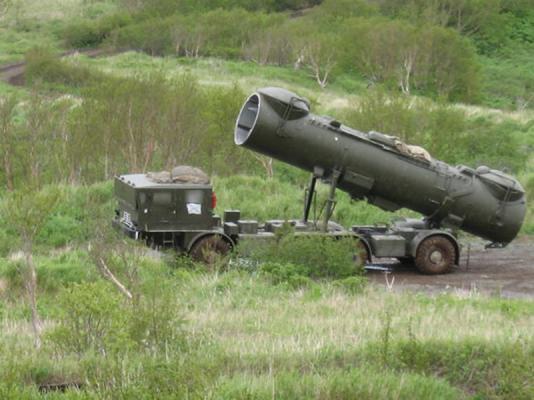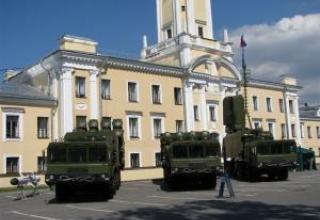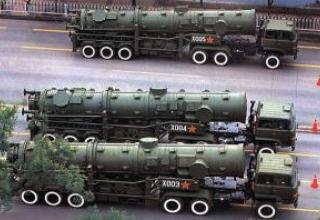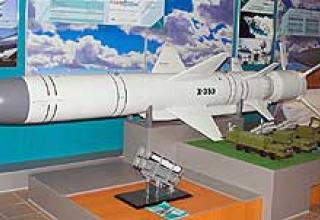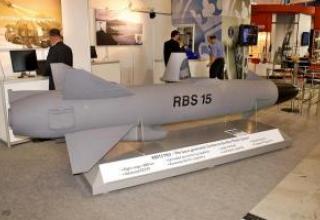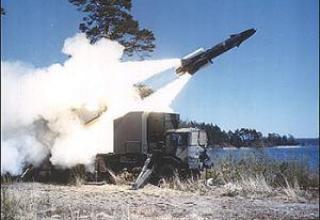The second generation coastal anti-ship operational-tactical missile system "Reduce" was developed under the leadership of V.M. Chelomey in the Design Bureau-52 in accordance with Decree of the USSR CM No. 903-378 of August 16, 1960 on the basis of the operational-tactical anti-ship missile P-35. The complex is designed to engage surface ships of all types. The missile of the coastal complex received the index P-35B.
The launcher is based on the four-axle chassis ZIL-135K (after the transfer of serial production of the chassis in Bryansk - Baz-135MB). The head developer of the control system of the Redoubt complex was NII-10 (Allair Research Institute). The missile's TRD march was developed at the Design Bureau-300.
Flight tests of the P-35B missile began in the autumn of 1963. By Resolution of CM № 631-202 of August 11, 1966 the Redoubt complex was adopted for service. In the Baltics, rearmament of the 10th Separate Coastal Missile Regiment with the Redoubt System started in 1972. The regiment was renamed the 1216th Separate Coastal Missile Division (OBRD). On November 1, 1974 the 1216th OBRD was reorganized into the 844th OBRD. In the Northern Fleet, the 501st Separate Coastal Missile Regiment, stationed on the Rybachy peninsula, was re-equipped with Reduce missiles in 1971-1974. July 16, 1961 was issued a Resolution of the CM for the rearmament of coastal stationary complexes "Utyos" from missiles "Sopka" to missiles P-35B. The first launch of the P-35B missile in the 362nd OBRP in Balaklava took place on 30 May 1971. Officially, both Balaklava divisions equipped with P-35B missiles were put into operation by the CM Decision of 28 April 1973. At present, the Balaklava divisions have been transferred to Ukraine. The rearmament of the stationary complex on Kildin Island (616th OBRP) was carried out in two stages: the first one on P-35B in 1976 and the second one in 1983.
The missile regiment of the Black Sea Fleet, equipped with the Reduce complex, was repeatedly transferred from the Crimea to Bulgaria on its own. There it held positions from which it could fire on the Dardanelles and parts of the Aegean Sea.
In 1974, the development of ZM44 "Progress" began on the basis of the P-35 complex. The main change in the missile was a new onboard guidance system with increased interference immunity and selectivity. New on-board electrical equipment units and a launch unit were developed for it, which provided better performance characteristics. The stealth and invulnerability of the missile in approaching the target has been increased by increasing the length of the final section of the trajectory for lowering the flight altitude in this section.
The following new technical solutions were applied in "Progress" complex in comparison with P-35 complex:
- a newly developed interference-proof radar vizier;
- automatic switch of the missile to autonomous search and target selection in the absence of commands from the launch vehicle;
- the flight altitude in the final section of the trajectory was reduced from 100-120 m to 20-40 m;
- the length of the final section of the trajectory has been increased from 20 km to 50 km;
- the logic of autonomous target selection has been introduced;
- the number of missiles in the salvo was increased to 16 when shooting from several carriers.
After state trials in 1976-1977, the "Progress" complex was recommended for adoption by the ships of projects 58 and 1134, as well as the coastal systems "Reduce" and "Utes". Officially, "Progress" was adopted in 1982. Production of rockets for coastal systems was conducted from 1982 to 1987.
Nothing is known about foreign modifications of the complex or about its production abroad. Most likely, the complex was exported in a limited way and no licenses for its production were transferred to any countries.
The designation of the US MOD missile is SSC-1B (Surface-to-Surface Cruise Type 1 is the second variant), the designation of NATO is Sepal.
Composition:
It is part of the complex:
- SPU-35B self-propelled launcher (SPU-35B) (see diagram)
- P-35B (3M44) missiles (see figure)
- cars with the control system "Rock" (4P45) and radar on the car chassis
The complex can receive target designation from Tu-95D, Tu-16D, Ka-25C helicopters (with "Success" radar).
Organizational launchers of the complex are grouped into batteries of 3 AP, five - six batteries (15 - 18 AP) make up a battalion, three battalions with support facilities make up a brigade (45 - 54 AP).
According to data for 1988, the fleet was in service:
- Baltic Fleet - 6 battalions
- Black Sea Fleet - 5 battalions
- Northern Fleet - 3 battalions
- Pacific Fleet - 5 battalions
Operation of the complex (see diagram)
In the technical position, the LPC is prepared and charged. The time of transition from marching to combat position is about 1.5 hours. The launchers and other vehicles of the complex are moved to the firing line on the defended coast. The LTP in position sets the container in a combat position (the elevation angle is 20 degrees). The complex brigade's radar detects the target, and the coordinates of the target are transmitted to the battalion, which accompanies the target and finds out if it belongs to the target by means of its own system. After that, the control system selects the PU for firing and launches the missile. When the missile is launched, a TRD march is launched and the missile is launched using two launch accelerators towards the target. After the missile leaves the container, the wing is opened. The missile gains speed and altitude using the missile's RTD launch accelerators. After the fuel is produced, the launch vehicle is reset and the rocket with a running marching engine is lowered to the marching altitude. The inertial control system maintains the specified altitude, speed and flight direction.
When the target area is reached, an active radar sight is activated. The missile transmits a radar picture of the target to the operator's console. The operator assigns a target to the missile, the CNS captures the target and points the missile at the target.
Blast unit is initiated by the fuse after the missile hits the target.
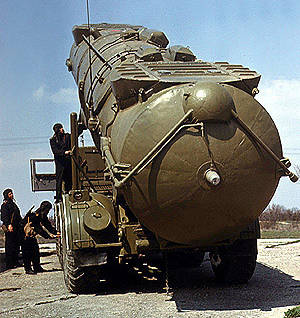
Advantages
The Redoubt rocket complex has a powerful combat unit and high marching speed, which increases the probability of hitting (breaking through the air defense) the target with a single missile or multi-missile with multiple PU. The systems currently in service most likely have a 3M44 "Progress" missile with improved TTH. Due to its long range, the Redoubt battery can cover the several hundred kilometers of coastline with external target designation. The powerful high-explosive or nuclear warhead allows to disable a ship of any class by one missile.
Shortcomings
The outdated rocket has a relatively large size and mass, so the LPS carries only 1 rocket. The LPS is not autonomous and cannot detect and fire targets by itself. The time it takes to deploy the complex in a combat position is long. The missile's long range creates problems with target designation.
Characteristics:
| Rocket | |
| Range of fire, km | 25 - 270 - 460 |
| The marching altitude of the rocket flight, m | 400 / 4000 / 7000 |
| Flight height at the end section, m. | 100 |
| Missile flight speed march, number M | 1,5 |
| Diving angle on target, deg | 80 |
| Time to deploy PP from the march, min. | at least 30 minutes. |
| Dimensions, m: | |
| - length | 9,45 (9,75; 9,88; 10) |
| - wingspan | 2,6 |
| - folding width | 1,544 |
| - max. housing diameter | 1,0 |
| - altitude | 1,5 |
| Mass of empty rocket, kg | 2330 |
| Launch mass of the rocket, kg. | 4 500 |
| Fighting unit | blast |
| Weight BC, kg | ~ 1000 |
| The power of the nuclear BC, kT | 350 |
| Type of start | tilted container, angle 20O |
| Governing bodies | airfoils |
| Guidance System | INS + active radar vizier |
| Marshal engine | TRD |
| Fuel | kerosene |
| Starter motor | two RDTTs |
| Traction, kgs. | 2 х 30 000 |
| Start engine running time, s | 2 |
| LAUNCHER | |
| Type | self-propelled wheel |
| Wheel formula | 8 х 8 |
| Mounted on chassis | ZEAL-135K (BASES-135MB) |
| PU weight, kg | 21 000 (around 18 000) |
| Dimensions in marching position, m: | |
| - length | 13,5 (11,5) |
| - width | 2,86 (2,8) |
| - altitude | 3,53 (3,0) |
| Maximum speed, km/h | 40 |
| Power reserve, km | 500 |
| The military calculation, man. | 5 |
Testing:
According to various data, apart from Russia, the Redoubt complex is armed with the coastal units of the following countries:
- Syria - 1 Battalion (18 SSU)
- Yugoslavia - several batteries
Nothing is yet known about the combat use of the Redoubt complex.
The Redoubt complex, despite its shortcomings, is still a powerful weapon of coastal units.
Sources:
- "Российское ракетное оружие 1943-1993", А.В. Карпенко, СПб,"Пика", 1993
- "Военно-Морской Флот СССР 1945-1991", В.П. Кузин, В.И. Никольский, СПб, Историческое Морское Общество, 1996
- "Оружие Российского Флота", А.М.Петров и др., СПб, Судостроение, 1996
- "Береговые ракетные комплексы ВМФ", А.В. Карпенко, N2 1997 Военный Парад
- А.Б.Широкорад "Оружие отечественного флота", Минск, Харвест, 2001г.
- http://twower.livejournal.com/
- http://www.npomash.ru/press/ru/podrobnee020612.htm?l=0

